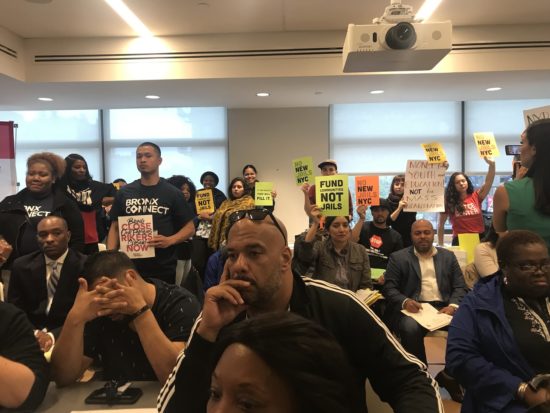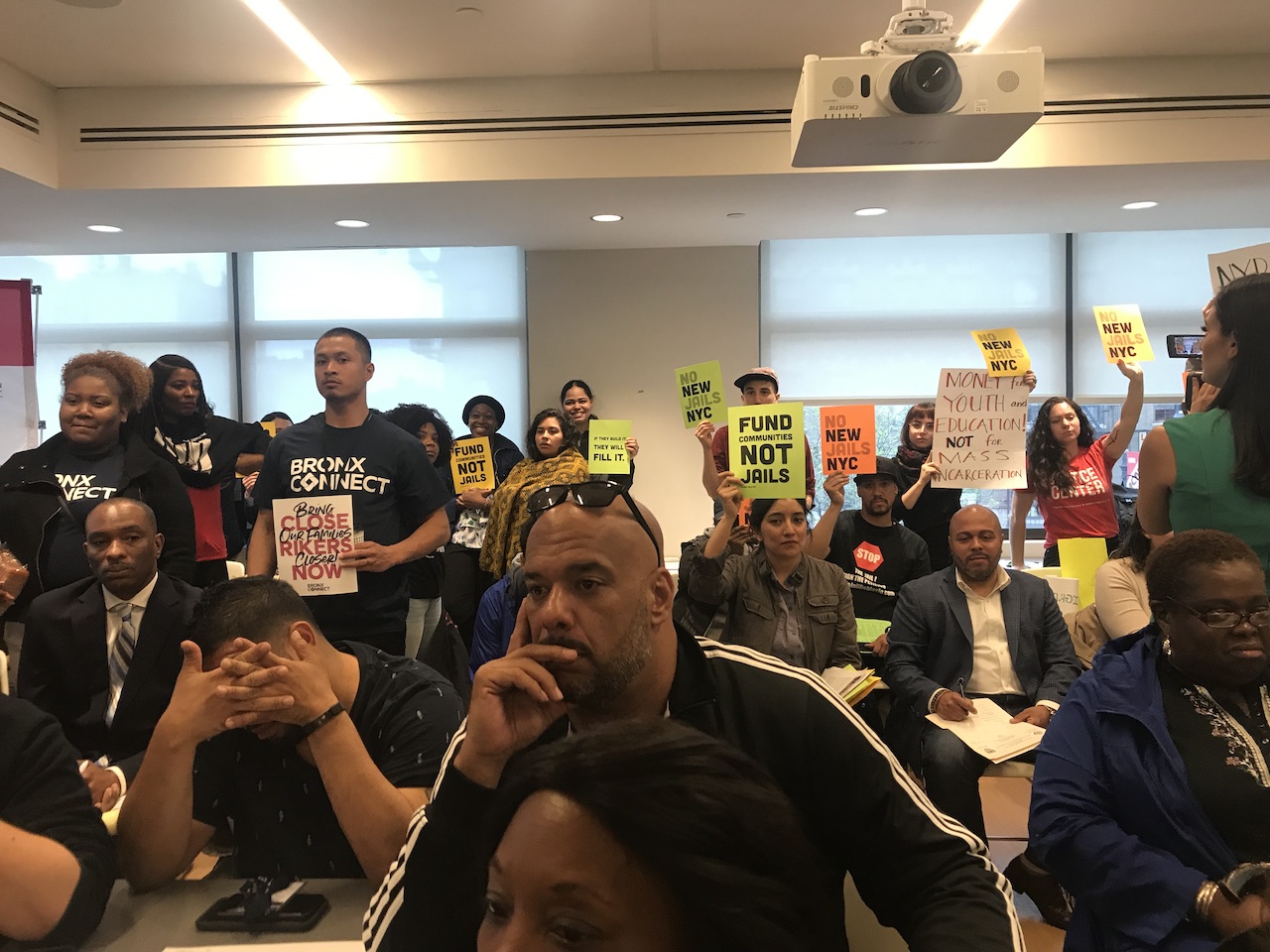
At its monthly meeting on May 15, Community Board 1’s Land Use Committee voted 13-0 to reject the city’s proposal to build a new jail on the site of an NYPD tow pound between Concord Avenue and the Bruckner Expressway at E. 141st Street.
Board 1’s advisory no-vote represents the first phase of the Uniform Land Use Review Process (ULURP) to certify the plan, and means that Board 1’s full body will almost certainly vote the plan down at its monthly meeting, which is scheduled to take place in Lincoln Hospital Auditorium, on Thursday, May 23rd at 6 p.m.
According to ULURP procedures, Borough President Ruben Diaz Jr. will have 30 days to decide on the plan after Board 1 sends him its final recommendation.. Diaz Jr. seems similarly inclined to turn down the proposal. He has led rallies to denounce the city’s selection of the tow pound, in Mott Haven and on the steps of City Hall. He and Board 1 members have repeatedly said that they support decommissioning the jails on Rikers Island and replacing them with more humane facilities, but have urged the mayor to build next to the courthouse on E. 161st Street instead.
Just as at a prior meeting to discuss the plan in April, Board 1 members at the May 15 meeting were sharply critical when city representatives presented details. Officials from the Mayor’s Office on Criminal Justice (MOC-J) and the corrections department told them that the 4.5 acre Mott Haven site is ideal because it is close to public transportation, close to the courthouse, and is one of few city-owned lots in the Bronx with enough square footage for a big facility.
“This is a huge effort of decarceration,” said Jordan Stockdale, Deputy Executive Director of MOC-J’s Close Rikers initiative. Recent data showing a decline in the number of New Yorkers who will need to be detained has led the city to downsize the original plan from 1,472 to 1,150 beds for each of the four new borough jails. Implementation of bail reform and alternative to incarceration programs will lead to a drop of about 9,000 in the inmate population by the time the new jails are built in 2016, the city predicts.
Selecting sites in Brooklyn, Queens and Manhattan was easy because those jails will be built where existing detention facilities already stand, but “in the Bronx it was a much more complicated process,” said MOC-J’s Deputy Director Dana Kaplan. Another benefit to the Bronx, Kaplan said, will be the decommissioning of the dilapidated Vernon C. Bain Center jail barge, which has been moored in the East River in Hunts Point since the 1990s.
But Board 1 members argued that the city is misguided. The Cypress Avenue 6 train stop is too small and deteriorated to be counted as a reliable public transit point, and transportation between a new jail and the E 161st Street courthouse will snarl already horrendous traffic, they argued. In addition, they contend that placing the jail in a low-income, residential area with a long history of violent crime, and within a few blocks of several schools, is a recipe for disaster.
“Across the street, on the other side of the Bruckner, they built a brand new school,” said Hakiem Yahmadi, a Board 1 member and former chair of Community Education Council for Mott Haven’s District 7. “There’s 12 districts in the Bronx. Why are you dropping it here?”
Arline Parks, Executive Director of the Diego Beekman Mutual Housing Association next to the proposed site, said that police from the 40th Precinct are already overwhelmed by violent crime in that area. New services ancillary to a jail for former detainees would lead to even more crime and further destabilize a sensitive neighborhood, she said.
“We did look at other sites that were closer to the courthouse,” responded Kaplan, but they were “smaller in square footage,” and would have led to design problems.
Others argued that the jail, which will be 245 feet high, will be too tall for the area.
“We’re working to understand how much the height will come down,” as a result of the proposed reduction in beds, said Kaplan.
The officials mostly reiterated design details they had announced at the contentious April meeting at Metropolitan College in Mott Haven, saying that the jail will be just part of a multi-use complex to include retail, community space and 235 units of affordable housing.
“We don’t need (the housing component) and all that fluff,” responded Board member Josephine Fernandez-Byrn, who accused the administration of “trying to bribe us.”
While the April meeting drew nearly 200 attendees—-dozens of whom emphatically told the city officials that no new jails should be constructed to replace Rikers once it is decommissioned—-only about two dozen attendees were at the May 15 committee meeting. They were evenly split between residents who oppose putting a jail in Mott Haven, some from the No New Jails coalition, and others from the Close Rikers contingent, which favors the city’s plan.
Concord Avenue homeowners Myra Hernandez and Wayne Soto Matamoros say they have been swayed by the argument not to build any new jails anywhere after RIkers closes. They had hoped to denounce jail plans at a Feb. 13 Neighborhood Advisory Council meeting that Councilwoman Diana Ayala had organized, and were incensed when Ayala called off that meeting at the last minute “due to unforeseen circumstances.” Local homeowners accuse Ayala, who supports the mayor’s plan, of trying to stack those meetings with supporters while deliberately keeping out opponents.
Hernandez was pleased that the land use committee voted no to a Mott Haven jail, but said that they should have “added conditions,” demanding no new jails be built.
“There was a lot of NIMBY speak,” said Hernandez. “If we have decreasing crime rates then why do they feel we should build more jails?”
Tara Brown-Arnell, director of Mott Haven-based Bronx Connect, said after the meeting that it had gone as she expected. Bronx Connect provides health and education initiatives for at-risk young people, and is a member organization of the Close Rikers campaign that supports the city’s plan.
“I expect them to say no,” said Brown-Arnell of Board 1’s decision, adding “I do believe these community facilities need to be built. This is part of the process. You put it anywhere and those who are near it are going to say no. Everyone wants a change but nobody wants to make sacrifices. So many people are missing the big picture.”
Still, Brown-Arnell said she is encouraged that everyone shares the understanding that Rikers should be shuttered as soon as possible.
“I hear them, but why don’t we start with the things we agree with,” she said.

